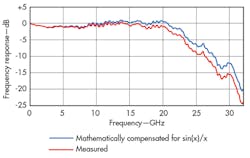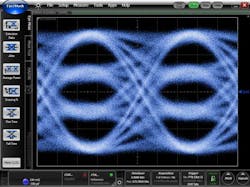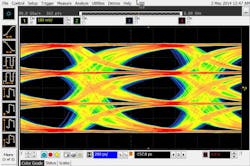AWG Delivers 20 GHz With 65 GSamples/s
This file type includes high resolution graphics and schematics when applicable.
Signals required for testing RF/microwave components, devices, and systems grow more complex with time, especially as the demands for wireless services grow and the limits on available bandwidth become apparent. Test signals must include sophisticated forms of modulation based on amplitude, frequency, phase, and even pulses. Fortunately, arbitrary waveform generators (AWGs) provide the means to transform requests for complex test signals into stable, low-noise outputs.
The new M8195A AWG from Keysight Technologies boasts some of the most outstanding performance levels yet to be achieved by these generators, with frequency bandwidth to 20 GHz using an 8-b, 65-GSamples/s architecture packed into a compact, one-slot AXIe module. Each one-slot module contains four digital-to-analog converters (DACs) operating at a maximum rate of 65 GSamples/s, with each M8195A AWG module capable of four differential output signals. This is a test signal source that can match the most advanced produce the most creative forms of modulation and even frequency-hopped signals with minimal jitter. This is a test signal source that can match the most advanced waveforms and the most creative forms of modulation—even frequency-hopped signals—with minimal jitter.
The M8195A AWG (Fig. 1) is available with one, two, or four differential channels per one-slot AXIe module; the module can be installed in a two-slot or five-slot AXIe chassis. The 65-GSamples/s sample rate can be maintained on all channels across an instantaneous bandwidth of DC to 20 GHz. The AWG features built-in frequency and phase calibration to produce wideband, multitone signals with flat frequency response to 20 GHz.
The phase-noise and spurious noise levels of these signals are low, but outputs can also be programmed with required amounts of noise and distortion for realistic testing of analog, digital, and optical systems. The M8195A can be programmed and controlled by means of a soft-front-panel application running on the AXIe embedded controller or, alternately, software running on an external personal computer (PC).
In addition, the M8195A can be controlled by SCPI and IVI-COM remote programming interfaces. The AWG is designed to work with a number of external software programs, including MATLAB from The MathWorks and LabView from National Instruments.
This is a competitive signal source for the many challenges of testing modern optical, RF/microwave, and digital systems. It can provide four independent analog output signals, allowing for advanced optical-communications component and system testing, as well as for driving optical systems that require a pair of independent in-phase/quadrature (I/Q) dual-polarized signals. The four output channels can be precisely synchronized in time, with femto-second resolution.
Modern optical communications systems are running with increasingly complex modulation formats as the amount of data to be handled increases, including quadrature-phase-shift-keying (QPSK) modulation, 16-state quadrature amplitude modulation (QAM16), and orthogonal-frequency-division-multiplex (OFDM) modulation. The M8195A can generate all of these modulation formats and more as required for optical communications testing.
In addition, the M8195A is a capable RF/microwave signal generator, offering wideband multitone signals and modulation formats to 20 GHz (Fig. 2; the available frequency range depends on the number of channels in use and the amount of available memory per channel). It can generate continuous-wave (CW), pulsed, and frequency-hopped signals with any type of amplitude- or phase-based modulation, such as QAM and PSK.
Because the M8195A attains a high-frequency limit of 20 GHz, it can be used without an external frequency upconverter for many applications, enabling waveform generation directly at the carrier frequency. Frequency switching speed for standard models is better than 505 μs and can be enhanced to 38 ps with frequency-switching option FSW.
In terms of digital signal generation, the M8195A can support testing across a wide range of multiple-level, multiple-channel digital interfaces with almost negligible jitter. The AWG includes digital predistortion techniques to control the frequency and phase responses of output signals for flexible testing.
For advanced testing, channels can be embedded and de-embedded by knowing the S-parameters of a target circuit or component under test and using these S-parameters to program the M8195A. The AWG offers excellent time-domain behavior for pulsed outputs, with typical 20%/80% rise/fall time of 18 ps (Fig. 3).
The M8195A can load new waveforms on the fly without interrupting the playback of waveforms in progress. Each AXIe module can pack as much as 16 GSamples/s of sample waveform memory (as an option), with 2 GSamples/s as a standard starting point. With its capability for multiple-module synchronization, as many as 16 synchronized channels can be produced from a five-slot AXIe chassis using four M8195A AWG modules.
This file type includes high resolution graphics and schematics when applicable.
Plotting Performance
This file type includes high resolution graphics and schematics when applicable.
In terms of performance, the M8195A AWG offers outstanding spectral purity by merit of its 8-b vertical resolution and 65 GSamples/s maximum sampling rate. It achieves an in-band spurious-free dynamic range (SFDR) of typically -80 dBc for outputs from DC to 1 GHz, -53 dBc from 4 to 8 GHz, -50 dBc from 8 to 10 GHz, -46 dBc from 10 to 12 GHz, and -42 dBc or better at frequencies above 12 GHz. Second-harmonic distortion is typically -45 dBc for output signals under 3 GHz, -35 dBc from 3 to 8 GHz, and -30 dBc above 8 GHz. Third-harmonic distortion is typically -35 dBc under 2 GHz and -30 dBc for output frequencies and 2 GHz and higher.
The phase noise for a 1-GHz carrier at 64 GSamples/s is -110 dBc/Hz offset 1 kHz from the carrier, -123 dBc/Hz offset 100 kHz from the carrier, and -140 dBc/Hz offset 10 MHz from the carrier. The time-domain performance is similarly impressive, with skew (peak-to-peak jitter) between any pair of outputs of 0 ±5 ps at a sampling rate of 32 Gb/s per signal. Residual jitter is less than 200 fs for 32-GBaud signals.
The M8195A also offers outstanding amplitude performance with single-ended outputs to +1 V peak to peak (pp) and differential outputs to +2 V pp across a voltage window of -1.0 to +3.3 VDC. The nominal amplitude resolution is 400 μV and the amplitude accuracy is typically ±2.5% ±10 mV. The DC offset accuracy is typically ±20 mV.
The AWG maintains flat frequency response across its wide bandwidth with the aid of an integrated 16-tap finite-impulse-response (FIR) filter. The amplitude flatness is typically ±2 dB from DC to 10 GHz, and typically within +2 to -3 dB from 10 to 20 GHz. This is an AWG that can generate signals with complex modulation that are clean (Fig. 4) or have controlled amounts of distortion (Fig. 5).
The M8195A offers an adjustable delay range for when compensation must be added for the electrical lengths of components such as coaxial cables. All four channels can be set with as much as 10 ns time delay, adjustable with 50-fs resolution and with accuracy of ±10 ps. These variable delay capabilities also can be used to synchronize the channels of multiple M8195A modules in time.
Each M8195A AWG module sports a reference-clock input port that accommodates signals from 10 MHz to 17 GHz. It can be used as the reference input for all channels in a synchronous system. The internal synthesizer clock of the M8195A has accuracy of ±2 ppm from 54 to 65 GHz with phase noise of better than -115 dBc/Hz offset 10 kHz from a 1-GHz carrier and better than -95 dBc/Hz offset 10 kHz from a 10-GHz carrier. Each M8195A AXIe module measures 322.25 × 30 × 281.5 mm and weighs 3 kg.
As many readers may know, Keysight Technologies is making a name for itself after spinning off earlier this year from Agilent Technologies (which itself started from Hewlett-Packard Co. some years ago). By building on modular instrument formats such as AXIe for the M8195A AWG and the PXI/PXIe modules for the earlier introduced microwave vector network analyzers (VNAs), the firm is providing a pathway for ease of measurement system integration and multifunction solutions.
Keysight Technologies, Inc., 1400 Fountaingrove Pkwy., Santa Rosa, CA 95403; (707) 577-2663
This file type includes high resolution graphics and schematics when applicable.
About the Author
Jack Browne
Technical Contributor
Jack Browne, Technical Contributor, has worked in technical publishing for over 30 years. He managed the content and production of three technical journals while at the American Institute of Physics, including Medical Physics and the Journal of Vacuum Science & Technology. He has been a Publisher and Editor for Penton Media, started the firm’s Wireless Symposium & Exhibition trade show in 1993, and currently serves as Technical Contributor for that company's Microwaves & RF magazine. Browne, who holds a BS in Mathematics from City College of New York and BA degrees in English and Philosophy from Fordham University, is a member of the IEEE.






